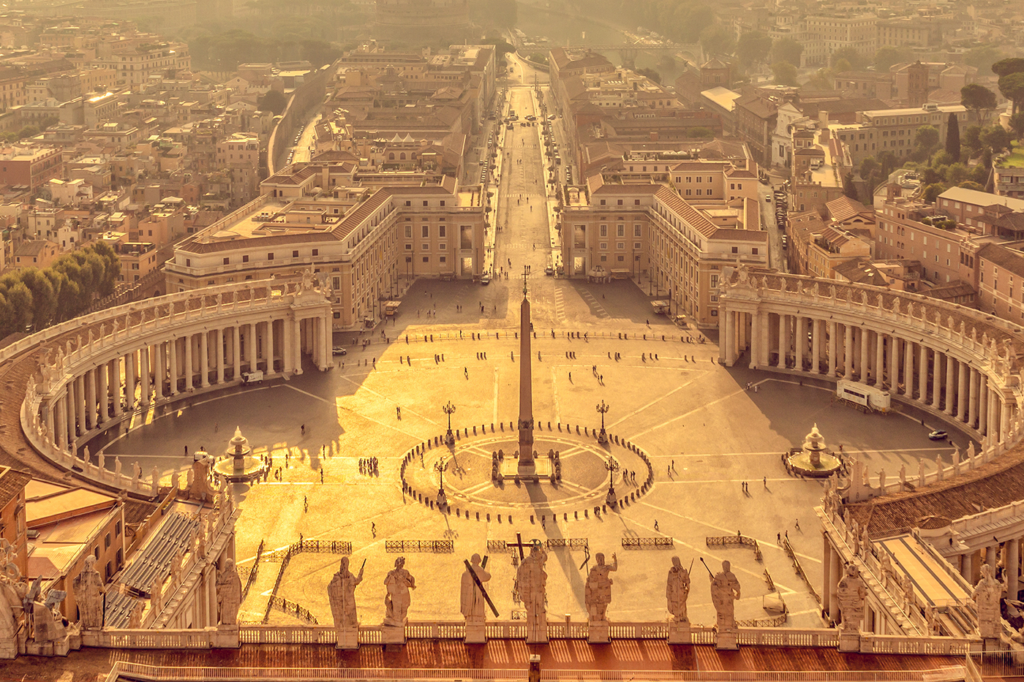This essay is part of our series on the relationship between Church and State. See the full collection of related articles here.
The Second Vatican Council’s Declaration on Religious Freedom, Dignitatis Humanae (DH), famously taught that individuals and religious communities have the right to act according to their conscience in religious matters, free from coercion by the civil authorities. At the same time, religious freedom should not be understood as a negation of the duty to seek out and worship God. Rather, as DH states, the Church’s teaching on religious freedom “leaves untouched traditional Catholic doctrine on the moral duty of men and societies toward the true religion and toward the one Church of Christ.”
Some recent commentators have read that latter passage as an attempt to minimize the apparent discontinuity between DH’s teaching on religious freedom and prior magisterial teaching that the Church can “direct” the state to use its coercive power for the spiritual good of its citizens. In this view, as a previous Public Discourse essay put it, a Catholic “confessional state” is the ideal proposed by Catholic doctrine. Indeed, DH itself affirms that “Government is . . . to help create conditions favorable to the fostering of religious life. . . .”
The philosopher Thomas Pink has argued that DH’s affirmation of the right to religious freedom should be understood as a re-articulation of the traditional teaching that religious matters are outside the competence of civil authorities. In Pink’s telling, DH does not reject the notion that the Church, by virtue of its responsibility for the spiritual good of society, has the authority to direct the state to use its coercive power for spiritual ends. The Declaration’s teaching that “religious freedom . . . is to be recognized as the right of all men and communities and sanctioned by constitutional law” reflects a “policy change” on the part of the Church rather than a development in doctrine.
Start your day with Public Discourse
Sign up and get our daily essays sent straight to your inbox.This reading of DH is linked to a resurgent Catholic integralism that insists that a liberal social order centered on personal autonomy alienates us from the truth about ourselves and our relationship with God. This critique of liberalism finds some echoes in recent magisterial teaching. For example, in his encyclical Caritas in Veritate, Pope Benedict XVI writes that, “Without truth, without trust and love for what is true, there is no social conscience and responsibility, and social action ends up serving private interests and the logic of power, resulting in social fragmentation, especially in a globalized society at difficult times like the present.”
Pope Benedict, however, embraced a more typical interpretation of DH. In an address in 2011 he asserted that religious freedom “is rooted in the very dignity of the human person” and rejected integralism as reflecting a “partial vision of the human person.” Indeed, Pink appears to recognize the incongruity between his own views and those of Benedict and his predecessor John Paul II, dismissing their teaching as “official theology” that can be distinguished from historical magisterial teaching. What are Catholics to believe about religious freedom in light of both DH and prior magisterial teaching? To answer this question, we must examine how that magisterial teaching has developed over the centuries.
In a classic articulation of Christian doctrine, Pope Gelasius I wrote the following in a letter to Roman Emperor Anastasius I in 494:
There are two, august Emperor, by which this world is chiefly ruled, namely, the sacred authority [auctoritas sacrata] of the priests and the royal power [regalis potestas]. Of these, that of the priests is weightier, since they have to render an account for even the kings of men in the divine judgment. You are also aware, most clement son, that while you are permitted honorably to rule over human kind, yet in divine matters you bend your neck devotedly to the bishops and await from them the means of your salvation.
In the reception and proper disposition of the heavenly sacraments you recognize that you should be subordinate rather than superior to the religious order, and that in these things you depend on their judgment rather than wish to bend them to your will. If the ministers of religion, recognizing the supremacy granted you from heaven in matters affecting the public order, obey your laws, lest otherwise they might obstruct the course of secular affairs by irrelevant considerations, with what readiness should you not yield them obedience to whom is assigned the dispensing of the sacred mysteries of religion?
Gelasius proposes that the Church and empire represent distinct authorities with jurisdiction over the “religious order” and the “public order,” respectively. Significantly, he also insists that civil authorities should be “subordinate” to the Church in religious matters, although the civil authorities have “supremacy” in their own realm.
Thomas Aquinas articulates the doctrine a different way. In his De Regno he claims that society, like the individual person, finds its ultimate end in the enjoyment of God, rather than in temporal fulfillment. Since this end lies beyond the powers of human nature, however, human rulers must be directed by the Church, the representative of Christ on earth, toward the attainment of this end: “For those to whom pertains the care of intermediate ends should be subject to him to whom pertains the care of the ultimate end, and be directed by his rule.” Civil authorities are responsible for governing worldly affairs “in such a way as to make it suitable for the attainment of heavenly happiness.”
Although the general outlines of the doctrine laid out by Gelasius and Aquinas are clear, key elements remain ambiguous. For example, how does one distinguish the “religious order” from the “public order,” the “spiritual” from the “temporal”? After all, St. Thomas Becket defied King Henry II and was ultimately martyred because he rejected the king’s claim that priests could be tried in the king’s courts for criminal offenses. In the twelfth century, “religious” and “secular” represented classes of people under distinct jurisdictions, a view very different from how the Church has seen things in more recent centuries.
As Aquinas’s remarks above also suggest, the fact that temporal affairs are ultimately aimed at “heavenly happiness” allows for an expansive definition of what falls under the spiritual authority of the Church. For example, in his 1931 encyclical Quadragesimo Anno, Pope Pius XI justifies his intervention in “social and economic matters” by asserting that the Church “can in no wise renounce the duty God entrusted to her to interpose her authority, not of course in matters of technique for which she is neither suitably equipped nor endowed by office, but in all things that are connected with the moral law.”
Just as importantly, Gelasius and Aquinas are ambiguous about what exactly it means for the civil authorities to be “subordinate” or “subject” to the Church. How does the Church exercise this authority and what sorts of things can the Church direct the civil authorities to do?
Perhaps the most well-known answer to these questions is the sixteenth-century prelate and theologian Robert Bellarmine’s theory of the “indirect power” of the Church over political authorities. In general, the Church must respect the authority of the state over temporal affairs. If the political authorities threaten the spiritual well-being of the people, however, Church leaders can intervene into political matters for the sake of the spiritual good: “[T]he Pope as Pope directly and immediately has no temporal power but only a spiritual power; nevertheless by reason of his spiritual power he has at least indirectly a power in temporal things, which is a supreme power.” Bellarmine developed these ideas not only to refute royal absolutists who denied any political authority to the Church, but also the so-called “hierocrats” who asserted that the pope had direct temporal authority over political rulers.
As the theologian John Courtney Murray points out, however, Bellarmine’s theory does not really ascribe an indirect power to the Church, but rather proposes a direct power exercised in exceptional circumstances. In Bellarmine’s view, the pope can make a judicial ruling, implement legislation, or even depose a ruler if the good of religion is at stake. The theologian Henri de Lubac argues that here Bellarmine confuses the Church’s legitimate authority over temporal matters with the exercise of temporal jurisdiction. In other words, the Church can act like a state, albeit in exceptional circumstances, in pursuit of spiritual ends. In de Lubac’s view, however, the Church must exercise its authority over temporal matters in a way consistent with its spiritual mission, of which the exercise of temporal jurisdiction is a betrayal.
By the nineteenth century, most Catholic theologians had abandoned the theory of the indirect power of the Church, instead embracing what could be called a “directive” power over temporal matters: the Church can direct political authorities by means of its spiritual authority, through an appeal to conscience, or in more serious situations through the imposition of excommunication or other canonical penalties. This abandonment of the notion of the Church exercising temporal jurisdiction, however, did not mean giving up the ideal of a confessional state, as is clear in Pope Leo XIII’s encyclical Immortale Dei (1885) and Libertas (1888). The Church can direct the state to use its coercive power for the good of religion, if circumstances demand it.
This perspective has been revived by contemporaries such as Pink, who writes here at Public Discourse:
[W]hen the state legislates and punishes for purely religious ends, such as to privilege a religion just on grounds of its truth or to further people’s salvation, it can only properly do so as agent for the authority of the Church—as the Church’s secular arm. And that the state, when publicly Christian and so directed by the Church, is bound to do—as canon 2198 of the 1917 Code reflects.
Although Pink explains that the Church can only exercise its authority over the baptized, this does not rule out directing Christian political authorities “to use coercion to defend her [i.e., the Church’s] jurisdiction against those unbaptized who interfere from without, proselytizing on behalf of false religions” and to punish heretics and schismatics. As previously noted, Pink argues that DH’s seemingly contradictory affirmation that individuals and religious communities should be able to believe and practice their religion free from state coercion does not represent a change in the Church’s teaching that the Church can direct the state to act in the ways described above, but rather a decision that in the present moment such action is inopportune.
Such an interpretation of DH is belied by a key passage:
It is in accordance with their dignity as persons—that is, beings endowed with reason and free will and therefore privileged to bear personal responsibility—that all men should be at once impelled by nature and also bound by a moral obligation to seek the truth, especially religious truth. They are also bound to adhere to the truth, once it is known, and to order their whole lives in accord with the demands of truth. However, men cannot discharge these obligations in a manner in keeping with their own nature unless they enjoy immunity from external coercion as well as psychological freedom.
DH does not treat the question of religious freedom as primarily a matter of jurisdiction, of who does and does not have the authority to use coercion in religious matters; rather, it asserts that religious freedom is the fitting precondition for fulfilling the obligation to seek and hold to the truth. As the theologian David L. Schindler explains in his commentary on DH, the declaration proposes a teleological understanding of religious freedom in which freedom and truth are intrinsically linked. The human person is drawn by nature to seek out and hold the truth whose fullness is revealed in God’s revelation in Christ, but this vision of human fulfillment implies a human subjectivity whose freedom must be respected as it seeks out the truth which fulfills it.
The genius of DH is that it demonstrates that the “traditional Catholic doctrine on the moral duty of men and societies toward the true religion and toward the one Church of Christ,” which had in the past been used to justify a coercive role for the state in religious matters, is instead the very basis for religious freedom. The implication of DH’s teaching is that the state cannot exercise coercion in religious matters even at the direction of the Church; the Church’s responsibility is to guide society toward the truth, but it must do so “in a manner in keeping with [persons’] own nature,” which excludes any form of state coercion.
The reasons for this dramatic development in Church teaching are simply an extension of the reasons why the Church ultimately found Bellarmine’s theory of indirect power unsatisfactory. The Church first found that its exercise of temporal jurisdiction was incompatible with the spiritual good that is its aim. What the Church has subsequently discovered is that the problem is not sidestepped by introducing the state as its agent. Rather, the problem was ultimately the use of temporal means, particularly state coercion, in pursuit of spiritual ends, whether those temporal means are exercised by the church or the state.
Regardless of who ultimately authorizes it, state coercion in matters of religious practice is a violation of the person’s inherent dynamism toward truth in freedom, unless that coercion is aimed at preventing conduct that violates the natural law (what DH calls “the just demands of public order”) rather than religious practice qua religious. This does not preclude the Church appealing to Christians’ consciences to shape public policy or even using the coercive means available to it for the same purpose (for example, withholding communion from politicians who steadfastly support abortion), as these are spiritual means appropriate to the spiritual ends at which the Church aims. Nor does it deny the state’s obligation to create “conditions favorable to the fostering of religious life,” as DH itself affirms. Rather, it is the recognition that those favorable conditions must include religious freedom if they are to be consistent with human dignity.














